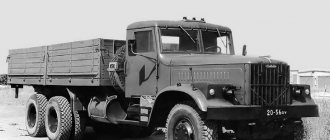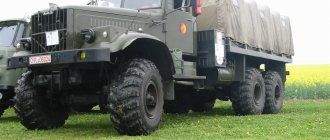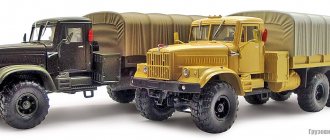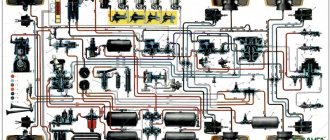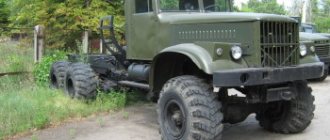Today we will talk about the famous “Laptezhnik” - this is how the KrAZ-255B heavy all-terrain truck was nicknamed in our country. This iconic car rightfully occupies a leading position among all Soviet heavy SUVs. This is not only a symbol of the Kremenchug Automobile Plant, but also a symbol of the Soviet era, one of the most popular trucks in the USSR in the last quarter of the twentieth century.
For almost two decades now, trucks of the KrAZ-255 family have not rolled off the assembly line in Kremenchug. But on the roads of our country, as before, you can often meet these mighty workers and soldiers. But the first copies of these trucks appeared about half a century ago.
A worthy heir to traditions
The need to modernize the KrAZ-214B model, which was quite successful for its time, but outdated in a number of technical parameters, arose in the mid-60s, and by 1967 Kremenchug automakers mastered the serial production of a new model of an all-wheel drive three-axle heavy truck. At the same time, the design of the truck has undergone significant changes.
KrAZ-214B from the plant museum
Externally, the new KrAZ was not much different from its predecessor. Perhaps only the new wide-profile tires indicated that the truck belonged to a new modification. It was thanks to the tires that the truck received its nickname “laptezhnik”, which took root among all those who operated this vehicle.
But the design of the truck itself has undergone major changes. And, first of all, this is a replacement of the power unit. The six-cylinder two-stroke diesel engine was replaced by a more powerful and economical V-shaped four-stroke eight-cylinder power unit YaMZ-238.
YaMZ-238
Let's compare some technical characteristics of the old and new modifications. The maximum speed increased from 55 km/h to 70 km/h, while fuel consumption decreased from 120 to 70 liters per 100 kilometers. Half a ton more than the previous model, with approximately the same curb weight. The carrying capacity of the KrAZ-255B also turned out to be. By equipping the vehicle with wide-profile variable-pressure tires with a unique tread pattern, the KrAZ-255B's cross-country ability has significantly increased.
However, VI-3 tires differed not only in their tread pattern and width. For the first time in the history of KrAZ trucks, the vehicle was equipped with a centralized tire pressure regulation system, which was controlled from the driver’s workplace. For example, when driving in deep snow or quicksand, the driver could reduce the tire pressure in just a few minutes from 3.8 to 1.0 atmospheres.
At the same time, the tire pressure on the supporting surface increased by 70%. As a result, the pressure of the wheels on the ground decreased, helping to increase the truck's maneuverability. This is the principle of operation of the centralized tire pressure control system. In 1979, the twelfth year of serial production, a more efficient dual-circuit braking system began to be installed on the 255th.
Timber carrier KrAZ-255L (1969). The photo shows a later version
0
Source:
“Laptezhnik” served as the basis for the creation of the KrAZ-255L timber truck. When coupled with a TMZ-803 semi-trailer, the timber carrier could transport up to 40 m3 of wood and transport timber in logs from 18 to 30 m along clearings where previously only tracked skidders worked. Tankers (ATs-8.5-255B), equipment for tankers (TZA-8-255B), truck cranes (KS-3572) and excavators (EOV-4421), fire-fighting equipment, as well as special superstructures for orders from the oil industry. The vehicle was used as a trailer tow for transporting oversized cargo and aircraft at airports. The car played a special role in the troops. It was used to tow artillery systems, as well as missile systems. The chassis was used to install equipment for radio engineering air defense troops and a pontoon-bridge park (PMP).
Laptezhnik in deserts and tropics
The foreign career of our “Laptezhnik” deserves a separate discussion. It was thanks to the interest shown in the truck by foreign customers that the Laptezhnik, unlike most Soviet trucks of that time, received a fairly wide range of colors.
At first, all serial Kremenchug trucks were painted in a protective color. However, after the All-Union Association “Avtoexport” managed to promote the new product of the Soviet automobile industry to the markets of Africa and Asia, the “Laptezhnik” in export version, at the request of customers, began to be painted in sand color.
Over the years of production, KrAZ trucks were exported to 50 countries around the world. They appeared on the roads of all continents, excluding Australia and Antarctica. Among other advantages, the truck stands out for its durability. Even after many years after the cessation of production, they can today be found not only in our country, but also where they were exported many years ago.
In Europe, most of them are in Poland and Germany. After the transition to NATO standards, the armed forces of the former socialist countries began to decommission Soviet equipment. Most of the cars ended up in the hands of private operators. In Poland, on the basis of former military KrAZ vehicles, tow trucks for vehicles were built, and in Germany, many fan trucks appeared that transport tourists in mountainous areas, participate in various auto shows, and some examples even become flagship cars in wedding processions.
Technical characteristics of the KrAZ cab
The KrAZ-255 cabin is three-seater, closed. The driver and passenger double seats are adjustable. There is a stove, a ventilation hatch, a driver's fan, rear-view mirrors, a sun visor, a storage box, a drinking water tank, a removable bed, and rugs.
KrAZ-255 cabin inside
The front windows are blown with warm air, a pneumatic windshield wiper, and a windshield washer are working. On the inside of the doors there is a pocket for documents and a place to install an ashtray. The windshield windows open, the rear window is solid, and the door glass is movable.
Numbers against the backdrop of a glorious history
Over the years of production, the Kremenchug Automobile Plant supplied about 82 thousand KrAZ-225 trucks of various modifications and versions to the Armed Forces of the USSR and allied countries. The year 1981 marked record deliveries, when KrAZ manufactured and delivered 5,591 vehicles to the USSR Armed Forces and for export.
In total, over the entire production period, 197,155 trucks of this family rolled off the assembly line of the Kremenchug Automobile Plant. After the collapse of the Soviet Union, the truck was produced for about two more years, however, in 1993 it was discontinued, giving way to more modern and economical models of off-road trucks. If we take as a basis the total number of cars produced during the Soviet period in Kremenchug, “Laptezhniki” make up a quarter of the volume of all trucks that rolled off the plant’s assembly line.
KRAZ-255 at the British military show
The KrAZ-225B family is one of the most successful projects not only of Kremenchug automakers, but also of the entire Soviet automobile industry. It is thanks to this that “Laptezhnik” rightfully became the symbol and personification of the Kremenchug brand.
Excavator superstructure EOV-4421 on KrAZ-255B chassis
0
Source:
The PMP kit made it possible to connect two tapes: in parallel or in series. With a parallel connection, the width of the roadway was 6.5 m, which ensured two-way traffic. The carrying capacity of the bridge was 60 tons, the length was 227 m. With a series connection, the length of the bridge increased to 323 m, although its carrying capacity was reduced to 20 tons. In addition, a heavy mechanized bridge (TMM) was mounted on the KrAZ-255B chassis to establish crossings across narrow rivers. Its kit included four bridge laying machines. The length of the bridge truss of one vehicle in the open position was 10.5 m. From the kit it was possible to assemble bridge crossings up to 42 m long. On the KrAZ-255B, attachments for digging pits and self-digging of a single vehicle were tested - the topic “Perimeter” (KrAZ-E255BP, 1969). A knife for cutting soil was placed at the back. Lowering the knife into the working position was ensured by two hydraulic cylinders driven by a pump from the truck transmission. The cut soil fell onto a flexible canopy made from sections of conveyor belt that was trailing behind the rear of the machine.
Soviet means excellent
Having assessed the appearance of the car and realizing how carefully the owner approached the issue of repair, I was amazed when I got into the KrAZ cab. But it's not easy to get there. The bottom step is almost at waist level. Therefore, to get into the cabin, you have to cling to the door and pull yourself onto the step. With such success, the KrAZ door can turn into a consumable unit with scheduled replacement every two weeks. But that's not what we're talking about. The truck cab is simply a pleasure to be in. Moreover, no re-equipment was carried out; almost everything is “native”. Is that at the feet of the passengers there is an additional stove, borrowed from the UAZ. In addition, a parking brake lever from a foreign car is installed, which is used to drive the hydraulic pump of the manipulator.
A homemade lever for turning on the manipulator pump is located “against the flow”
The perfect order is striking: not a single grain of sand on the floor or seats, the instrument panel is specially painted light green. According to the owner, the color of the KrAZ panel is identical to the color of the panel of a combat aircraft, where a pleasant color is used to rest the pilot’s eyes. But this is on an airplane, but relaxing behind the wheel of a KrAZ truck - of course, you need to be able to do that! There is nothing but iron all around, but the cabin is wooden, there is no sound insulation. How did people even work on it, let alone relax?! In terms of the overall sensations, such equipment can really be compared to a combat aircraft.
Thanks to the additional heater, the KrAZ is quite warm; foggy windows thaw, just like in a car. “Windshield wipers” with an archaic pneumatic drive perfectly clean glass. All devices work, which is surprising for our equipment that is almost 20 years old.
Another point that demonstrates the scrupulous approach to re-equipping a truck is the installation of “fog lights”. Considering that the current Traffic Rules prohibit the use of fog lights without low beams, a blocking relay is installed in the cab, which does not allow the use of fog lights without low beams. But the point is not even in them - evaluate the approach to the matter itself.
Transmission
The tractor-trailer is equipped with a mechanical five-speed transmission YaMZ-236N. Gears 2, 3, 4, and 5 are synchronized. Torque is transmitted from the engine through a double-disc friction dry clutch with a mechanical drive. The transfer case is two-stage, equipped with a locking center differential for the middle and rear axles.
The KrAZ-255 uses a standard model as a clutch, which is used on all vehicles with similar overall dimensions and operating specifications. It has the following technical characteristics and properties:
- clutch type – friction;
- two disks engage;
- the design uses cylindrical springs;
- The discs themselves operate without lubrication, there is no oil bath.
Since the KrAZ engine was developed quite a long time ago, it does not provide for the installation of an automatic transmission. That is why the truck is equipped only with a manual transmission. It has the following design features:
- fixed shaft axes are used;
- there are gears that are in constant mesh (excluding first gear and reverse gears);
- the box is three-way;
- number of gears – five;
- There are synchronizers that compensate for the lack of a divider (used in KamAZ) and work in second-third and fourth-fifth gears.
The transfer case has the following features and technical specifications:
- type – mechanical;
- includes power take-off shaft (for winch);
- There are two stages and a center differential.
The cardan transmission consists of several main parts:
- open type shafts;
- intermediate supports;
- cardan shafts.
The KrAZ is equipped with three drive axles, and it is thanks to them that it is famous throughout the world for its amazing maneuverability.
The design of the front axle has some features: it contains CV joints (additional constant velocity joints). They are responsible for transmitting torque to the front wheels during turning.
Attention! On the middle axle there is a special platform intended for mounting the rear axle driveshaft support.
The front and rear suspensions have different designs and technical characteristics:
- the front one rests on two semi-elliptical springs, which are equipped with a pair of shock absorbers (hydraulic, working in both directions);
- The rear suspension is mounted on two semi-elliptical longitudinal springs (equipped with three pairs of reaction bars).
The brake system is standard, it differs only in its rather large weight.
It includes the following elements:
- brake pads;
- brake drums;
- pneumatic drive and vacuum booster;
- additional brake motor (decelerates).
The braking distance of a car at various weights:
- at a speed of 40 km/h – 17 m;
- at a speed of 40 km/h with a trailer – 18.5 m.



